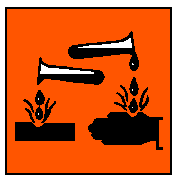International Chemical Safety Cards
| DICHLOROACETIC ACID | ICSC: 0868 |
DICHLOROACETIC ACID |
 |
| TYPES OF HAZARD/ EXPOSURE |
ACUTE HAZARDS/ SYMPTOMS |
PREVENTION | FIRST AID/ FIRE FIGHTING |
| FIRE | Not combustible. Gives off
irritating or toxic fumes (or gases) in a fire. |
|
Powder, water spray, foam,
carbon dioxide. In case of fire in the surroundings: all extinguishing agents allowed. |
| EXPLOSION | |
In case of fire: keep drums,
etc., cool by spraying with water. |
|
| EXPOSURE | PREVENT GENERATION OF MISTS!
AVOID ALL CONTACT! |
||
| INHALATION | Burning sensation. Cough.
Laboured breathing. Unconsciousness. Symptoms may be delayed (see Notes). |
Ventilation, local exhaust, or
breathing protection. |
Fresh air, rest. Artificial
respiration if indicated. Refer for medical attention. |
| SKIN | Redness. Pain. Blisters. |
Protective gloves. Protective
clothing. |
First rinse with plenty of
water, then remove contaminated clothes and rinse again. Refer for medical attention. Wear
protective gloves when administering first aid. |
| EYES | Redness. Pain. Severe deep
burns. |
Face shield, or eye protection
in combination with breathing protection. |
First rinse with plenty of water
for several minutes (remove contact lenses if easily possible), then take to a doctor. |
| INGESTION | Abdominal cramps. Burning
sensation. Sore throat. Unconsciousness. Vomiting. Weakness. |
Do not eat, drink, or smoke
during work. |
Rinse mouth. Do NOT induce
vomiting. Refer for medical attention. |
| SPILLAGE DISPOSAL | STORAGE | PACKAGING & LABELLING | ||
| Collect leaking liquid in
sealable containers. Cautiously neutralize remainder. Then wash away with plenty of water.
Do NOT let this chemical enter the environment (extra personal protection: complete
protective clothing including self-contained breathing apparatus). |
Separated from metals,
combustible and reducing substances, strong oxidants, strong bases, food and feedstuffs.
Tightly closed. Cool. |
Do not transport with food and
feedstuffs. C symbol R: 35 S: 26 UN Hazard Class: 8 UN Packing Group: II |
||
| SEE IMPORTANT INFORMATION ON BACK | ||||
|
||||